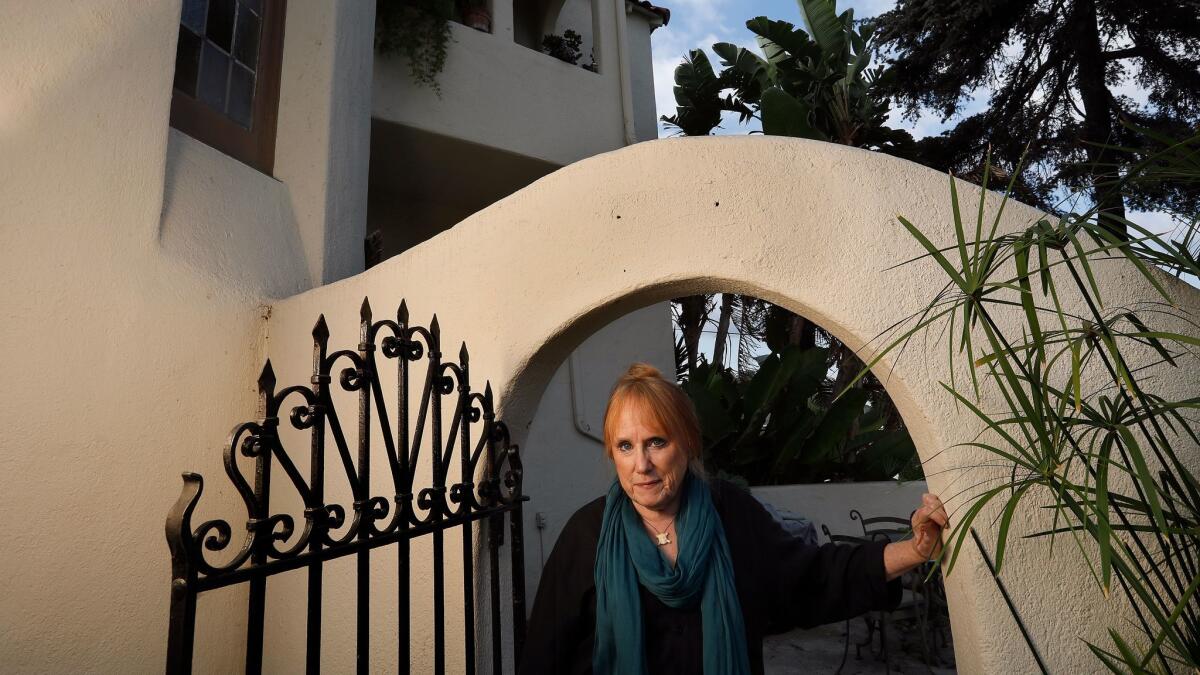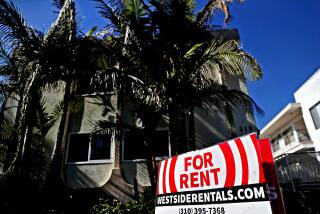For tenants on the edge, paying the rent often takes more than half their income
Even before their latest rent increase, Barbie Thompson and her husband, Juan, could barely afford the Rancho Santa Margarita apartment where they raised two children.
The company that paid her around $13 an hour to distribute samples at Costco often kept her on a part-time schedule, Thompson said. Her husband earned even less as a busboy. So to make ends meet, at times the couple used a food pantry, let auto bills lapse and turned their $1,845 rent in late — a budgeting tool that cost $50 in late fees.
“Sometimes we were down to the last couple of dollars,” said Thompson, who estimated she and her husband spent at least 57% of their gross income on rent and utilities. “There was never enough.”
And that was before the landlord raised the rent on their two-bedroom unit to more than $1,930.
California’s high housing costs have pushed many tenants to the edge of affordability. Even if they have steady work, the cost of putting a roof over their heads demands a staggering share of income.
The problem has been building for decades, a result of rising rents and stagnant income for many lower- and middle-class workers as the economy shifted away from manufacturing to create a legion of low-wage service jobs.
“I don’t think it’s any stretch that our homeless numbers are going to rise,” said Elise Buik, chief executive of United Way of Greater Los Angeles. “We have so many families on the edge.”
In 2016, 29% of California tenants put more than half their income — before any deductions — toward rent and utilities, according to an analysis by the California Budget & Policy Center. Housing costs are considered to be a burden on finances when they surpass 30% of income; more than half, or 54%, of California renters were paying that much.
The share of renters living on the edge has risen in fits and starts through years of economic expansion and contraction.
Back in the days of “Ozzie and Harriet,” in 1960, just 11.9% of U.S. renters put more than half their income toward rent and utilities, according to Harvard University’s Joint Center for Housing Studies. By 1980, the number in California was up to 20.2%.
One reason rents have risen steadily in California is a lack of apartment construction relative to job and population growth. And even though low-wage work has exploded in many corners of the state, California has added many well-paying jobs as well. Those workers bid up prices, particularly in the San Francisco Bay Area and Southern California.
Those who are less well-off have to make tough decisions: move to a cheaper area or cut back on cellphone services, restaurant outings and other, more necessary items.
Michael Flood, president of the Los Angeles Regional Food Bank, said he usually sees a sharp decline in households looking for help as the economy improves. But this time around it’s been only a slight decrease — something he attributes chiefly to rising housing costs.
“We are hearing more and more people say, ‘I am working … but the rents are just killing me,’” Flood said.
Concepcion, a 40-year-old mother of three who requested only her first name be used because she fears deportation, entered the U.S. illegally as a teenager. She said it’s hard getting by with a rent and utility payment that comes to about 40% of what her husband earns each month at three jobs.
She said it’s been hard to find better-paying work because she and her husband are here illegally. She lost a hospital job a few years back because of her immigration status.
So when it comes time to pay the $820 monthly rent for their Santa Ana apartment, the stay-at-home mom and part-time nursing student said she sometimes has only $10 to cover two days of food for herself and three kids.
Her husband isn’t home for dinner. She said he leaves at 4:30 a.m. and is sometimes back as late as 2 a.m. the next day, working as a landscaper and at two restaurants.
“Most of the times I feel like a single mother,” Concepcion said. “Everywhere I go, I am alone with my kids. They say, ‘Why is he never here? Why does he work so much?’ Even though I try to explain to them the reasons why he is not there, they just don’t get it.”
For many, finances simply can’t stretch any further. A study this year from real estate website Zillow found 2,000 more L.A. County residents would be pushed into homelessness by a 5% rent hike.
That’s what happened after Thompson’s rent rose 5% in fall 2015.
With the goal of making more money, she said, she quit her part-time job and took on two seasonal gigs, one directly with Costco and another at a grocery store “cutting fruit in the middle of the night.”
She recalled sometimes working 16-hour days, but still couldn’t pay January’s rent and was evicted.
For months, until they found a unit through a transitional housing program, Thompson said, they stayed with friends and relatives or paid $100 a night to sleep at a hotel.
Sometimes, she and her husband pulled their minivan into the parking lot of the Laguna Niguel Wal-Mart. They slept there with their two dogs, while their two teenagers stayed with an uncle.
After rising steadily since 1960, the share of U.S. renters spending more than half their incomes on housing flatlined from 1990 to 2000, a time when rents rose just slightly faster than incomes. The share was also flat in California.
Then during the first decade of this century, the share in both the state and the nation surged amid the housing bubble and weak wage growth. It jumped further in the wake of the financial crisis when millions lost their jobs.
By the end of the decade, median renter incomes adjusted for inflation had actually fallen nearly 12% from 2000, while rents were 10% higher, according to an analysis from NYU.
Then in 2011, the share of renters spending over half their income on housing hit an all-time high of 27.9% nationwide, in part because of a surge in rental demand from young adults as well as people who lost their homes in foreclosure. The share has since fallen as the economy recovered, but at 25.2% it remains historically high.
“It sounds kind of simple-minded to say it, but renter income hasn’t been going up very fast and rents have been going up fast,” said Rolf Pendall, co-director of the Urban Institute’s Metropolitan Housing and Communities Policy Center.
In the Los Angeles region, the median rent when adjusted for inflation increased 55% from 1980 to 2014, to $1,294, according to a study from website Apartment List. Incomes rose only 13%.
Economists and urban planning experts said income growth has been sluggish for a variety of reasons, including the loss of well-paying manufacturing jobs, declining union power and increased competition from low-wage workers in China and other developing countries.
With more limited options today, many workers without a college degree have turned to minimum-wage restaurant work, contract jobs or employment in the so-called gig economy.

In theory, rent growth shouldn’t consistently soar past gains in income.
But Richard Green, director of the USC Lusk Center for Real Estate, said his research shows that while rising incomes push rents up, when incomes fall, rents don’t always fall as much because landlords don’t want to earn less money.
In economically vibrant places such as California, too little apartment construction has also put sharp upward pressure on rents. In the high-income job centers of San Francisco and San Jose, many residents have been able to absorb the rent hikes, while poorer renters are pushed to outlying areas.
The places with the highest burdens tend to be places such as Los Angeles, with both high housing costs and a large population of low-wage workers.
“To some extent, this is a function of what has happened in the economy in the last few decades — we have seen rising income inequality,” said Ingrid Gould Ellen, director of the NYU Furman Center for Real Estate and Urban Policy.
“People at the low end, their incomes haven’t changed, but they are in a housing market where housing is being bid up by those at the higher income end of the spectrum.”
The heaviest rent burdens are borne by low-income households and those with children.
To pay for the one-bedroom place he shares with his 5-year-old daughter in Long Beach’s affluent Belmont Heights, Cal State Long Beach adjunct professor Alfredo Carlos started teaching additional courses during summer and winter break several years ago, along with an extra online class at another college during the regular school year.
Even so, Carlos said 33% of his gross income goes to rent and utilities. He recently canceled his cable subscription and cut back his cell usage to save more.
Carlos wants his daughter to have a bigger place when she gets older, but worries he won’t be able to afford one in a safe neighborhood.
“It’s a nice community for my daughter to live,” he said of Belmont Heights. “At some point, I am going to have to make a decision.”
For seniors on fixed incomes, rising rents are an ever-tightening clamp.
Lois DeArmond, a retired costume illustrator, said she already spends about 70% of her fixed income on a $1,855-a-month, two-bedroom unit in the Arlington Heights area of L.A.
The 69-year-old said she’s somewhat lucky because she can sometimes take an odd job and her unit is under rent control, which limits annual increases for current tenants — usually to 3%. But she worries even those increases will eventually become too much to bear. Already there’s little left for emergency expenses, let alone luxuries.
“It’s hard,” DeArmond said on a recent afternoon, growing quiet as she sat in her living room. “I just try not to think about it.”
Follow me @khouriandrew on Twitter
More to Read
Inside the business of entertainment
The Wide Shot brings you news, analysis and insights on everything from streaming wars to production — and what it all means for the future.
You may occasionally receive promotional content from the Los Angeles Times.











